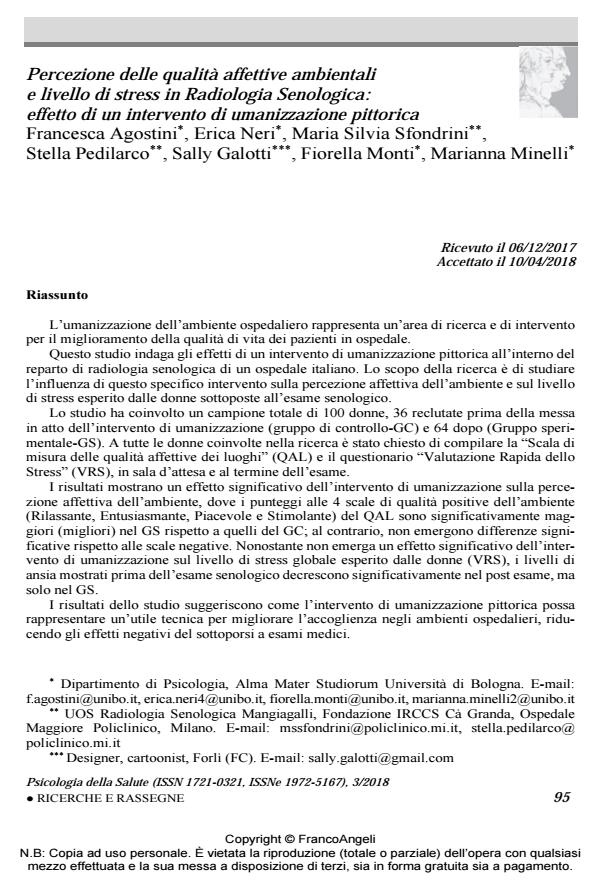Perception of affective qualities of environment and stress level in Radiology Unit: The effect of a pictorial intervention
Journal title PSICOLOGIA DELLA SALUTE
Author/s Francesca Agostini, Erica Neri, Maria Silvia Sfondrini, Stella Pedilarco, Sally Galotti, Fiorella Monti, Marianna Minelli
Publishing Year 2018 Issue 2018/3
Language Italian Pages 19 P. 95-113 File size 220 KB
DOI 10.3280/PDS2018-003005
DOI is like a bar code for intellectual property: to have more infomation
click here
Below, you can see the article first page
If you want to buy this article in PDF format, you can do it, following the instructions to buy download credits

FrancoAngeli is member of Publishers International Linking Association, Inc (PILA), a not-for-profit association which run the CrossRef service enabling links to and from online scholarly content.
Pictorial intervention in hospital environments represents a relevant research field in re-search and intervention for the improvement of the quality of life for patients in hospital. This study investigated the effects of a pictorial humanization intervention in a Breast Radiology Unit of an Italian hospital. The aim of the study was to study, in a sample of women undergoing to breast cancer screening, whether the pictorial intervention impacted the women’s perceptions of affective qualities of hospital environment and their levels of distress. The total sample consisted of 100 women, 36 recruited before the pictorial intervention was performed (Control Group-CG), and 64 after its implementation (Index Group, IG). Before and after the medical examination, all participants were asked to complete the "Scales of the Affective Quality Attributed to Place" (QAL) and the "Rapid Stress Assess-ment Scale" (VRS). Results showed a significant effect of pictorial intervention, with all 4 positive affective domains of QAL (Relaxing, Exciting, Pleasant, Stimulating) reporting significant higher (improved) scores in the IG compared to the CG. However, no significant differences emerged for what concerns the QAL negative domains. Although there were no significant differences between IG and CG scores at global levels of stress (VRS), women’s anxiety levels significantly decreased after the examination, but only in the IG group. Our findings suggest that the pictorial intervention could be particularly useful in order to create more welcoming hospital environments and to reduce negative effects associated with medical screening examinations.
Keywords: Pictorial humanization, hospital environment, affective quality of environment, stress, Breast Radiology.
- Parental Distress and Affective Perception of Hospital Environment after a Pictorial Intervention in a Neonatal Intensive Care Unit Erica Neri, Federica Genova, Marcello Stella, Alessandra Provera, Augusto Biasini, Francesca Agostini, in International Journal of Environmental Research and Public Health /2022 pp.8893
DOI: 10.3390/ijerph19158893 - Parents' and nurses' affective perception of a pictorial intervention in a pediatric hospital environment: Quasi-experimental design pre-post-testing Lea Godino, Elisa La Malfa, Mattia Ricco, Stefano Mancin, Elisa Ambrosi, Manuela De Rosa, Barbara Martelli, Virginia Lepore, Latifa El Mouttaqi, Sergio Cinocca, Marcello Lanari, Domenica Gazineo, in Journal of Pediatric Nursing /2024 pp.89
DOI: 10.1016/j.pedn.2024.03.021
Francesca Agostini, Erica Neri, Maria Silvia Sfondrini, Stella Pedilarco, Sally Galotti, Fiorella Monti, Marianna Minelli, Percezione delle qualità affettive ambientali e livello di stress in Radiologia Senologica: effetto di un intervento di umanizzazione pittorica in "PSICOLOGIA DELLA SALUTE" 3/2018, pp 95-113, DOI: 10.3280/PDS2018-003005